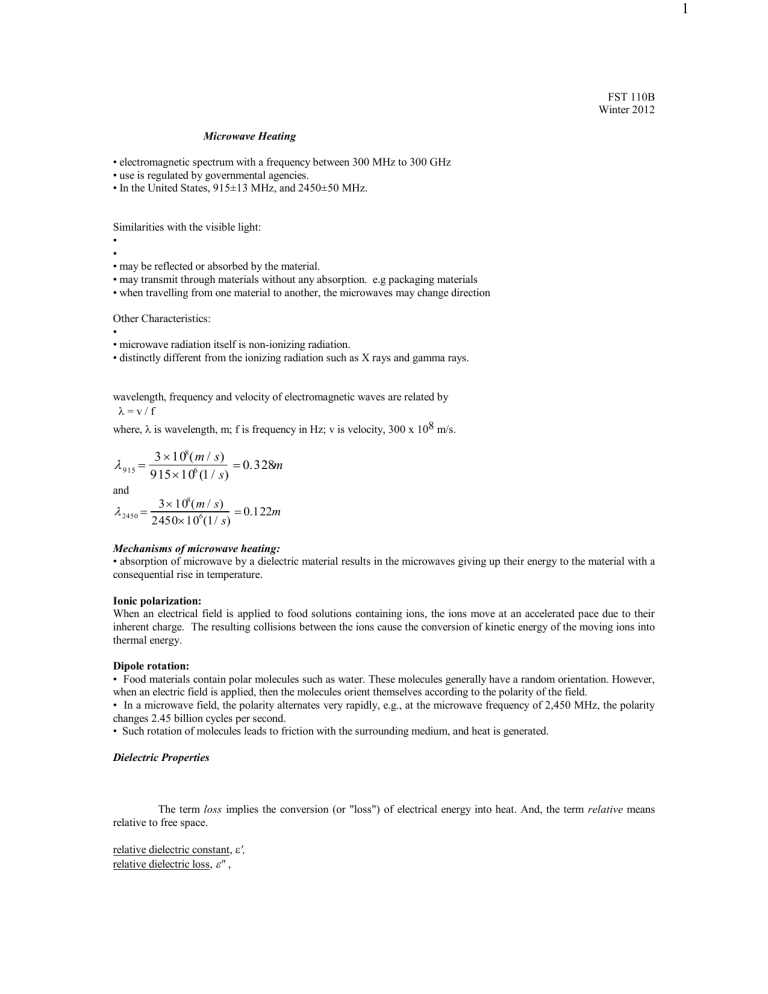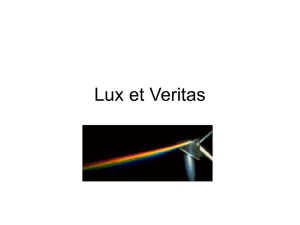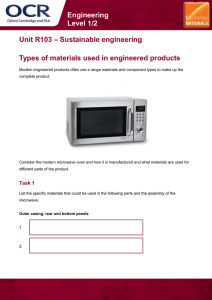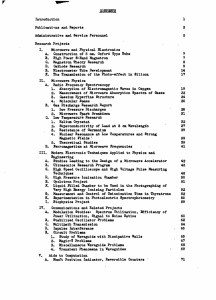Heating In A microwave oven - food engineering rpaulsingh

FST 110B
Winter 2012
Microwave Heating
• electromagnetic spectrum with a frequency between 300 MHz to 300 GHz
• use is regulated by governmental agencies.
• In the United States, 915±13 MHz, and 2450±50 MHz.
Similarities with the visible light:
•
•
• may be reflected or absorbed by the material.
• may transmit through materials without any absorption. e.g packaging materials
• when travelling from one material to another, the microwaves may change direction
Other Characteristics:
•
• microwave radiation itself is non-ionizing radiation.
• distinctly different from the ionizing radiation such as X rays and gamma rays. wavelength, frequency and velocity of electromagnetic waves are related by
= v / f where, is wavelength, m; f is frequency in Hz; v is velocity, 300 x
m/s.
915
3
10 8 ( m / s )
915
10
6
(1 / s )
0.328
m and
2450
3
10 8 ( m / s )
2450
10
6
(1/ s )
0.122
m
Mechanisms of microwave heating:
• absorption of microwave by a dielectric material results in the microwaves giving up their energy to the material with a consequential rise in temperature.
Ionic polarization:
When an electrical field is applied to food solutions containing ions, the ions move at an accelerated pace due to their inherent charge. The resulting collisions between the ions cause the conversion of kinetic energy of the moving ions into thermal energy.
Dipole rotation:
• Food materials contain polar molecules such as water. These molecules generally have a random orientation. However, when an electric field is applied, then the molecules orient themselves according to the polarity of the field.
• In a microwave field, the polarity alternates very rapidly, e.g., at the microwave frequency of 2,450 MHz, the polarity changes 2.45 billion cycles per second.
• Such rotation of molecules leads to friction with the surrounding medium, and heat is generated.
Dielectric Properties
The term loss implies the conversion (or "loss") of electrical energy into heat. And, the term relative means relative to free space. relative dielectric constant, ', relative dielectric loss, " ,
1
These properties provide an indication of the electrical insulating ability of the material. Foods are in fact very poor insulators, therefore, they generally absorb a large fraction of the energy when placed in a microwave field resulting in instantaneous heating
The dielectric loss factor for the material, ", which expresses the degree to which an externally applied electric field will
be converted to heat, is given by
" = ' tan
The loss tangent, tan , provides an indication of how well the material can be penetrated by an electrical field and how it dissipates electrical energy as heat.
Conversion of microwave energy into heat
• The microwave energy in itself is not thermal energy, rather heating is a consequence of the interactions between microwave energy and a dielectric material.
• The conversion of the microwave energy to heat can be approximated with :
PD = 55.61 x
10-14 E2 f ' tan where PD is the power dissipation, watt/cm3; E is the electrical field strength in volt/cm; f is the frequency in Hz; ' is the relative dielectric constant and tan is the loss tangent.
(The dielectric constant, ', and the loss tangent, tan , are the properties of the material, and the electrical field strength,
E, and frequency, f, represent the energy source).
• Increasing the electrical field strength has a dramatic effect on the power density, since the relationship involves a square term.
For transient heat transfer in an infinite slab, for a one dimensional case,
2 x
T
2
q
k
c k p
t
T
Penetration depth of microwaves
• The distribution of energy within a material is determined by the attenuation factor, '.
2
2
1
tan
2
1
1
2
• The penetration of electrical field can be calculated from the attenuation factor. T
• The depth, Z, below the surface of the material at which the electrical field strength is 1/e that of the electrical field in the free space, is inverse of the attenuation factor.
Z
2
2
1
tan
2
1
1
2
• microwave energy at 915 MHz penetrates more deeply than at 2450 MHz.
• The depth of penetration for microwave power is usually described in two different ways.
The penetration depth is the distance from the surface of a dielectric material where the incident power is decreased to 1/e of the incident power. The Lambert's expression for power absorption gives, where Po is the incident power, P is the power at the penetration depth, d is the penetration depth, factor.
' is the attenuation
2
If the power is reduced to 1/e of the incident power at depth d
P/Po = 1/e
2 'd = 1
d = 1/2 '
The second definition of the penetration depth is stated in terms of half-power depth,
• the half-power depth is the distance from the surface of a material where the power is one-half of the incident power.
P/Po = 1/2 e-2
'd = 1/2 solving for d d = 0.347/ '
Microwave Oven
Power Supply -- The purpose of the power supply is to draw electrical power from the line and convert it to the high voltage required by the magnetron. The magnetron usually requires several thousand volts of direct current.
Magnetron or power tube -- Magnetron is an oscillator capable of converting the power supplied into microwave energy. The magnetron emits high frequency radiant energy. The polarity of the emitted radiation changes between negative and positive at high frequencies.
Wave guide or transmission section -- The wave guide propagates, radiates, or transfers the generated energy from the magnetron to the oven cavity. In a domestic oven, the wave guide is a few centimeters long, whereas in industrial units it can be a few meters long. The energy loss in the waveguide is usually quite small.
Stirrer -- The stirrer is usually a fan-shaped distributor which rotates and scatters the transmitted energy throughout the oven. The stirrer distrurbs the standing wave patterns, thus allowing better energy distribution in the oven cavity. This is particularly important when heating non-homogenous materials like foods.
Oven cavity or oven - The oven cavity encloses the food to be heated within the metallic walls. The distributed energy from the stirrer is reflected by the walls and intercepted by the food from many directions with more of less uniform energy density. The energy impinging on the food is absorbed and converted into heat.
• The size of the oven cavity is influenced by the wavelength.
• The length of the cavity wall should be greater than half wavelength and any multiple of a half-wave in the directon of the wave propagation.
• The wavelength of 2450 MHz frequency was earlier calculated to be 12.2 cm, therefore the oven cavity wall must be greater than 6.1 cm. The oven cavity door includes safety controls and seals to retain the microwave energy within the oven during heating process.
Microwave heating of foods
Heating of foods in a microwave field offers several advantages in contrast to more conventional methods of heating.
Following are some of the important features of microwave heating that merit consideration.
Speed of Heating:
Frozen Foods:
Ice
Water (@25˚C)
Relative Dielectric
Constant
'
3.2
78
Relative Dielectric Loss
Constant
"
.0029
12.48
Loss Tangent tan
.0009
0.16
Shape and density of the material:
.
Food composition:
3




